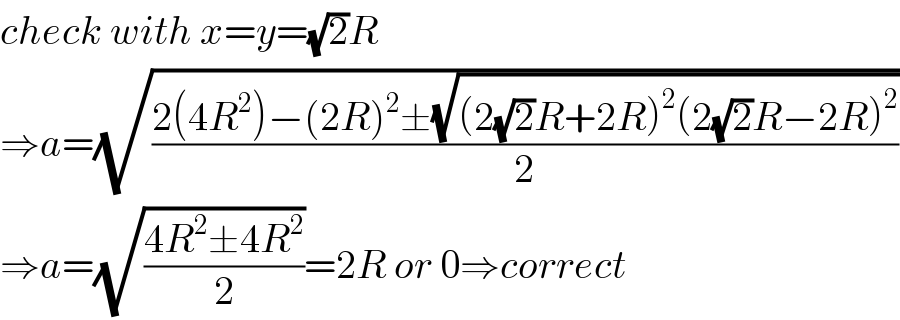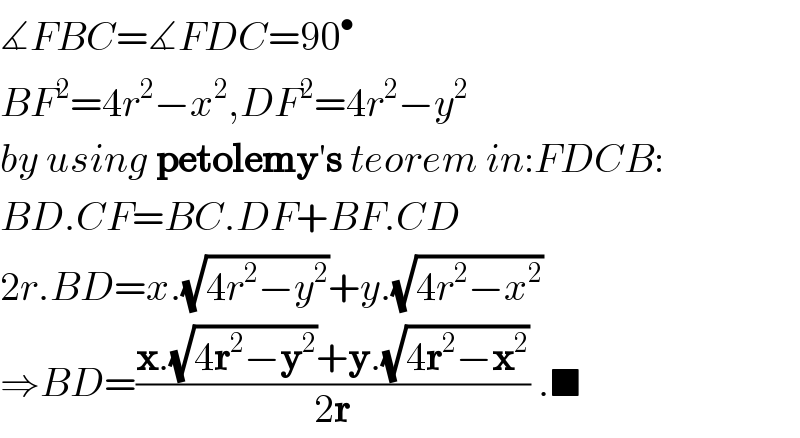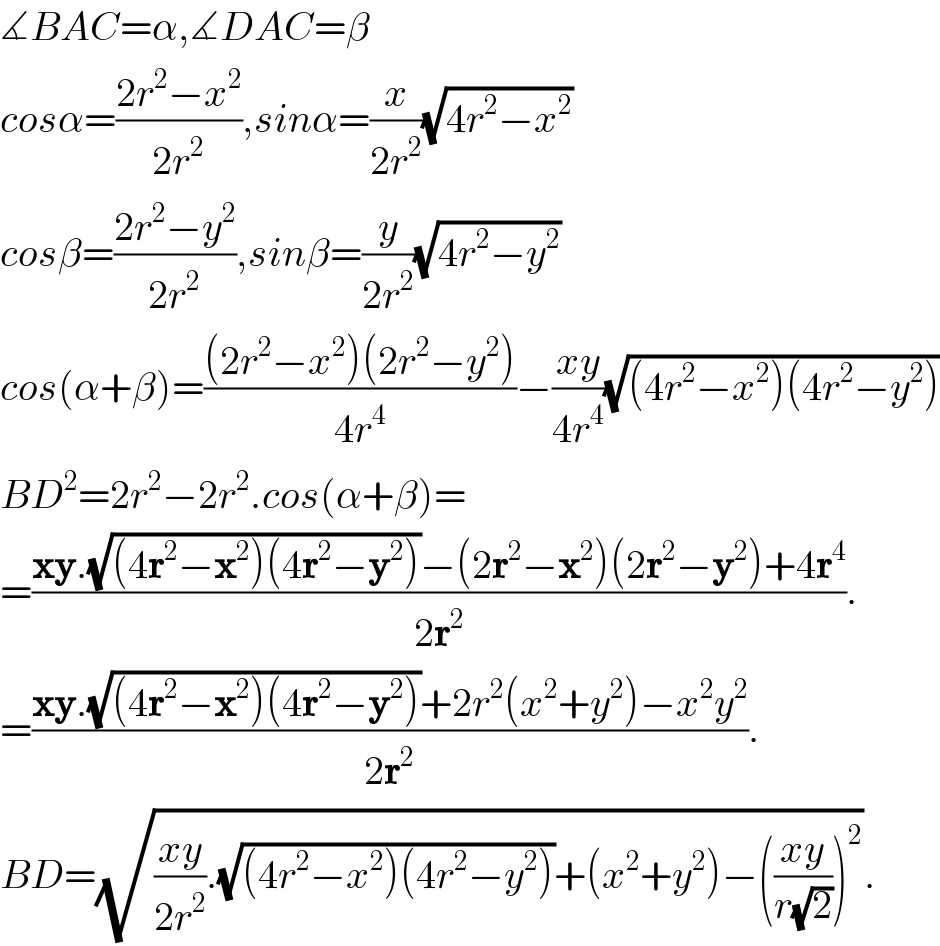
Question and Answers Forum
Question Number 49433 by behi83417@gmail.com last updated on 06/Dec/18

Commented by ajfour last updated on 06/Dec/18

Commented by behi83417@gmail.com last updated on 06/Dec/18

Commented by behi83417@gmail.com last updated on 07/Dec/18
![BD=a ∡BAD=α=BC^⌢ D ∡BCD=β=((BD^⌢ )/2)=((360−BC^⌢ D)/2)=180−((BC^⌢ D)/2) cosBC^� D=−cos((1/2)BA^� D) cos^2 β=((1+cosα)/2)⇒2cos^2 β−cosα=1 2(((x^2 +y^2 −a^2 )/(2xy)))^2 −((2r^2 −a^2 )/(2r^2 ))=1⇒ 4r^2 (x^2 +y^2 −a^2 )^2 −4x^2 y^2 (2r^2 −a^2 )=8r^2 x^2 y^2 4r^2 a^4 −4a^2 [2r^2 (x^2 +y^2 )−x^2 y^2 ]+4r^2 (x^2 +y^2 )^2 −16x^2 y^2 r^2 =0](Q49455.png)
Commented by behi83417@gmail.com last updated on 07/Dec/18

Commented by mr W last updated on 07/Dec/18
![sir, but your eqn. differs from mine. yours is after rearrangement a^4 −[(x^2 +y^2 )−((x^2 y^2 )/r^2 )]a^2 +(x^2 −y^2 )^2 =0 mine a^4 −[2(x^2 +y^2 )−((x^2 y^2 )/r^2 )]a^2 +(x^2 −y^2 )^2 =0 can you please check?](Q49504.png)
Commented by mr W last updated on 07/Dec/18

Answered by mr W last updated on 06/Dec/18
![let a=BD R=((xya)/(√((x+y+a)(−x+y+a)(x−y+a)(x+y−a)))) R=((xya)/(√([(x+y)^2 −a^2 ][a^2 −(x−y)^2 ]))) [(x+y)^2 −a^2 ][a^2 −(x−y)^2 ]=(((xy)/R))^2 a^2 a^4 −[2(x^2 +y^2 )−(((xy)/R))^2 ]a^2 +(x^2 −y^2 )^2 =0 a^2 =((2(x^2 +y^2 )−(((xy)/R))^2 ±(√([2(x^2 +y^2 )−(((xy)/R))^2 ]^2 −4(x^2 −y^2 )^2 )))/2) a^2 =((2(x^2 +y^2 )−(((xy)/R))^2 ±(√([4x^2 −(((xy)/R))^2 ][4y^2 −(((xy)/R))^2 ])))/2) a^2 =((2(x^2 +y^2 )−(((xy)/R))^2 ±(√((2x+((xy)/R))(2x−((xy)/R))(2y+((xy)/R))(2y−((xy)/R)))))/2) ⇒a=(√((2(x^2 +y^2 )−(((xy)/R))^2 ±(√((2x+((xy)/R))(2x−((xy)/R))(2y+((xy)/R))(2y−((xy)/R)))))/2))](Q49444.png)
Commented by behi83417@gmail.com last updated on 06/Dec/18

Commented by mr W last updated on 07/Dec/18

Answered by behi83417@gmail.com last updated on 06/Dec/18

Commented by behi83417@gmail.com last updated on 06/Dec/18

Commented by behi83417@gmail.com last updated on 07/Dec/18
![chech for:x=y=r(√2) BD=((r(√2).r(√2)+r(√2).r(√2))/(2r))=((4r^2 )/(2r))=2r [ok].](Q49524.png)
Answered by behi83417@gmail.com last updated on 07/Dec/18

